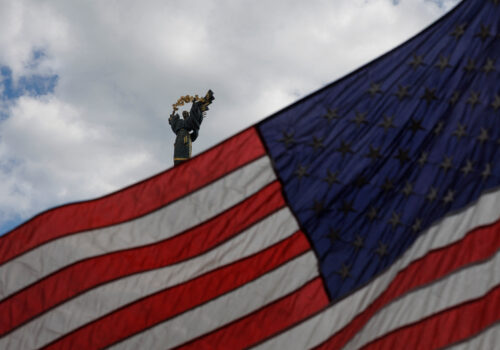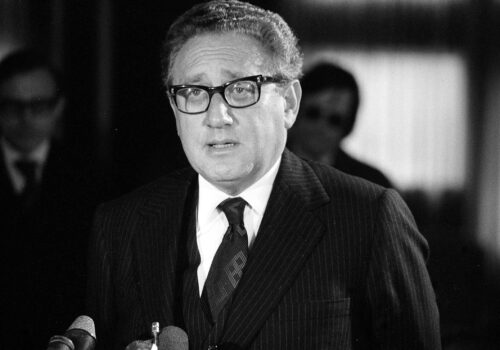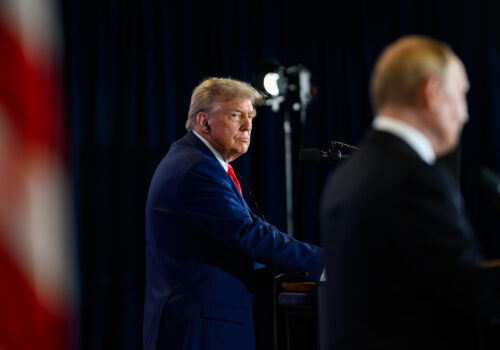Dispatch from Ukraine: The path to a durable peace is emerging
From a secret Ukrainian waterfront location, I follow my trainer’s directions on how to steer a kamikaze sea drone, this time not armed with explosives, from a gamer’s console toward an imagined target at sufficient speed to lift the boat’s nose above the waves.
The technology is so advanced and the payload so devastating that Western partners are beating a path to Ukraine to witness and invest in the future of modern warfare. Ukrainian sources say that the Trump administration is in the early stages of negotiating what could amount to a fifty-billion-dollar, five-year deal in which the two sides would jointly produce ten million drones a year—doubling Ukraine’s forecasted output for 2026.
Welcome to the front lines of freedom, well into the fourth year of Russia’s criminal, unprovoked, and now-stalemated war—the deadliest and most consequential European conflict since World War II. With Ukraine’s airports still closed, those heading to the country must undertake a minimum fourteen-hour train or car ride from Poland to Kyiv. My trip to the Ukrainian capital this month began with a visit to our hotel’s bomb shelter, three floors below the lobby, at check-in. An average of two air-raid alarms a night followed, easily heard without even downloading the ear-piercing app that sends out alerts.
Amid these wartime realities, ample doses of bravery, ingenuity, resilience, and national pride have kept Ukrainians’ hope alive—the hope to survive and eventually thrive as a sovereign, independent, secure, and democratic state, anchored in the European Union (EU) and someday also in NATO. This powerful hope, along with shifts in battlefield dynamics and US and European support for Ukraine, is opening previously unthinkable paths toward ending the war.
Three scenarios for Ukraine’s future
Ukrainians know that a complete and just victory in this war is impossible for the moment. Such a victory would involve Ukraine regaining the roughly 20 percent of its territory that the Kremlin has seized, receiving billions of dollars of war reparations from Russia, and witnessing the international prosecution of Russian President Vladimir Putin and other top Moscow officials for their war crimes. At the same time, Ukrainians are just as convinced that Russia will never achieve Putin’s maximalist goal of taking all of Ukraine and installing collaborators as leaders of the country.
That leaves three more realistic possibilities. The least desirable is an extended war of attrition, which would favor Russia given its larger population, military, and manufacturing base. Nearly as bad is what Ukrainian officials call a “fake peace,” in which Russia stops the fighting for a time but under conditions that fail to secure Ukraine or prevent a future attack. The best outcome among plausible scenarios is a fair and durable peace with some Ukrainian territory lost for now but European military boots on the ground, an American security backstop, and an accelerated path to EU membership for Ukraine.
There’s a sense in Ukraine that the third scenario is more likely today than it was at the beginning of this year, when the Trump administration appeared ambivalent about Ukraine’s fate and European inattention endangered the country’s future. For now, US President Donald Trump has begun supporting Ukraine more. And Europe has experienced what Atlantic Council nonresident senior fellow Oksana Nechyporenko describes to me as an “awakening” about its own security perils, which “has brought Ukraine a second wind” of military, political, and financial support, including additional sanctions on Russia.
Here in Ukraine, the war against Russia has morphed into a combination of high-stakes diplomacy with the United States and Europe, an existential and accelerating technological race against Russia, a series of cloak-and-dagger operations against a fast-responding enemy, and an increasing number of long-range strikes into Russian territory that have expanded and remade the battlefield.
A new US-Ukraine diplomatic dynamic
Ukrainian officials remain humble about their ability to predict Trump’s next moves regarding Ukraine, but they believe the meeting last month in New York between Trump and Ukrainian President Volodymyr Zelenskyy produced a new diplomatic dynamic between the two leaders and their countries. That meeting resulted in substantial gains in several respects: leveraging Russia’s blocked state assets, increasing punitive measures against Russia’s economy, providing Ukraine with greater access to US weapons, and pursuing a potential mega-deal for joint drone production.
In his meeting with the Ukrainian leader, Trump confirmed US readiness to support, alongside Europe, a fund that could produce as much as $90 billion of long-term loans for Ukraine. These loans would be based on the collateral of more than $300 billion of blocked Russian assets, and Ukraine could use them to buy Western weaponry now rather than wait to fund these efforts via Russian reparations, which might not come for many years, if at all.
Though Trump didn’t use the term “sanctions,” he told his Ukrainian counterparts that he favored punitive tariffs and restrictive economic measures against Putin to push him to more rapidly and willingly negotiate peace. These measures include actions against Russia’s big energy companies and, together with Europe, against countries such as India and China, which are purchasing Russian oil and thus supporting the Russian economy.
The Ukrainian side provided Trump with a long list of weapons they would like to purchase, including more air-defense systems and longer-range strike missiles, such as the Tomahawk, which the Biden administration had prevented them from using. Ukrainian officials have argued that they needed to be able to “mirror” Russia’s attacks deep into their territory that are aimed at taking out energy-related infrastructure. It was after his meeting with the Ukrainians that Trump said publicly that Ukraine could and should regain territory that it has lost to Russia, which he called a “paper tiger” with a weak economy.
The two sides also agreed to start work on a drone deal that would greatly expand Ukraine’s manufacturing capacity to as many as twenty million drones, half of which would be used for the war with Russia and half of which would be sold to the United States. Delegates from the two countries have been meeting to iron out details and determine which of Ukraine’s air, sea, and ground drones would be most interesting to Washington.
With all of that as context, Zelenskyy agreed again to meet with Putin without preconditions, perhaps as early as the Group of Twenty (G20) summit hosted by South African President Cyril Ramaphosa in November.
No choice but to press on—and fast
One of the strongest impressions I got on the ground in Ukraine is that the war is now characterized more by a technology race than a battle for territory, though one informs the other. The advanced drone technology that both sides are employing is increasing the ever-expanding width of the “kill zone” on the front lines—the area within which soldiers can’t survive and tanks can’t travel without being destroyed—to twenty kilometers or more.
“We’re experiencing another revolution in military affairs,” Andriy Zagorodnyuk, Ukraine’s former minister of defense and a distinguished fellow at the Atlantic Council’s Eurasia Center, tells me. “Victory will go to the side that comes up with solutions faster. The goal of our technology ecosystem is to evolve faster than the enemy,” and hence bring about Russia’s “functional defeat through strategic neutralization of Russian capabilities.” In short, he says, the war primarily has become one more against time than for territory.
Ukraine is also facing a Russian military that is rapidly adapting to Ukrainian defense-tech innovations, leveraging its advantages in building at scale over Ukraine’s innovative dynamism. Russian drones, often of Iranian manufacture, now fly at heights up to 5,000 meters, making them increasingly difficult to intercept. Fast-evolving Russian countermeasures mean that any newly built Ukrainian drone becomes obsolete in two months. Engineers fighting alongside soldiers are rushing to innovate more quickly than the enemy.
As a result of these factors, shorter-range artillery has grown less important. Instead, Ukraine’s military is focused on three types of weaponry: weaponized, multirotor, first-person-view drones needed to hold the front line; advanced interceptor drones, powered through artificial intelligence to counter Russian attacks; and deep-strike drones to disrupt airports and hit targets such as oil refineries in Russia. Estimates vary, but experts say that Ukraine has taken out somewhere between 17 to 38 percent of Russian refinery production, disrupting Russia’s economy and likely making Putin and his people feel more vulnerable. Still, the “mirroring” is not exact; Ukraine avoids civilian targets while Putin prioritizes them.
Much has been made in Western media of Ukrainians’ war-weariness and the fact that they are outnumbered in terms of soldiers available to fight. We’re repeatedly told that Putin is fighting a long war of attrition that he believes he can win, given the West’s lack of staying power and the eventual erosion of Ukrainians’ will to fight.
Though I also sensed some societal exhaustion in Ukraine, more prominent was an often-repeated conviction that Ukrainians have no choice but to continue their fight against Russian aggression, given the historic stakes and the unacceptable alternative of national surrender. Ukrainians are proud that they have achieved the once-improbable war goal of holding off the Russians for more than three years and seven months. This effort has more deeply established their national identity and military capability while advancing their dreams of Western integration.
Ukrainians understand that their major front-line vulnerability lies not in themselves but in the uncertainty of US support and European capabilities. Russia, many here fear, is more secure in its reliance on China, North Korea, and Iran, without which Moscow wouldn’t have the finances, technology, or weaponry to stay in the fight.
“Ukrainians want to help Trump be a historic figure”
A long lunch with a prominent Ukrainian business leader, who discussed sensitive matters with me not for attribution, underscored Ukrainian pragmatism and determination. Ukrainians watched Trump’s red-carpet treatment of Putin in Alaska on August 15 with the intensity of the potentially doomed. But the disappointing outcome of that meeting, this businessman believes, has provided Trump with greater clarity that his path to historic legacy runs through Ukrainians and not Russians.
The businessman speaks positively about the political “miracle” of Trump’s reelection comeback and of his commendable desire to end wars and senseless bloodshed. He praises his attempt in Alaska to win over Putin to a genuine peace effort. However, the business leader says, “It will always stay in his mind and haunt him that he offered Putin applause, a handshake, a red carpet, and a ride in his armored car, and Putin responded with treachery and insult.”
The business leader recalls Trump’s comment in the Oval Office to Zelenskyy in February that the Ukrainian president had no cards to play. Now, the businessman says, it’s becoming more clear to Trump that Ukraine has three very significant cards: first, the strength of the Ukrainian people; second, the strength of Ukraine’s armed forces; and third, the bravery of its president.
The Ukrainian business leader believes that the US president himself could add the Trump card of American support, making it a stacked deck in favor of Ukraine. “Putin must be made by Trump to pay the price for Alaska,” he said. “Trump didn’t win the election ultimately to lose to Putin. It’s clear there are now two possibilities: Putin wins and Trump fails, or Trump wins and Putin fails. Russia winning this war is also China winning against the United States.”
The businessman pauses, reflects, and concludes: “Ukrainians want to help Trump be a historic figure.”
The war in Ukraine has repeatedly defied expectations, yielding nearly four years of inspiring Ukrainian resistance and a revolution in military affairs. I came away from my trip to Ukraine encouraged that, as momentum begins to shift in Kyiv’s favor, a just and durable peace for Ukraine could be within reach as well. With American consistency, European determination, and continued Ukrainian resilience, bravery, and technological innovation, the once-unimaginable may yet again become possible.
Frederick Kempe is president and chief executive officer of the Atlantic Council. You can follow him on X @FredKempe.
This edition is part of Frederick Kempe’s Inflection Points newsletter, a column of dispatches from a world in transition. To receive this newsletter throughout the week, sign up here.
Further reading
Mon, Sep 29, 2025
Dispatch from Kyiv: Why so many Americans support—and should continue to support—Ukraine
New Atlanticist By William B. Taylor
On a recent trip to Kyiv, a former US ambassador to Ukraine shares what he has heard from Americans, including anger at Russian atrocities and a hope in Ukrainian success.
Fri, Oct 3, 2025
What Kissinger would do about Putin and Ukraine
New Atlanticist By
Supporting a free and democratic Ukraine and ending the war there are decidedly in US interests, the late US secretary of state would have emphasized.
Tue, Sep 2, 2025
It’s time for Trump to put maximum pressure on Putin
Inflection Points By Frederick Kempe
The US president can have no further doubt about who he’s dealing with in the Russian president. There’s also little doubt about what is needed to end the war on terms that secure peace and preserve Ukrainian freedom.
Image: In the Donetsk region, Ukraine, on December 19, 2024, a soldier from the special aerial reconnaissance unit of the National Police of Ukraine, ''Khyzhak,'' holds an FPV drone in his hand during hostilities near the city of Toretsk, Donetsk region, eastern Ukraine. (Dmytro Smolienko via Reuters Connect)



